



A Learning Collaborative to Improve Care for Unhealthy Alcohol Use: Lessons Learned from Baseline HEDIS Performance Junqing Liu, PhD Research Scientist National Committee for Quality Assurance Addiction Health Services Research Conference October 17, 2019
What is HEDIS? H ealthcare Health care’s most -used tool for improving performance E ffectiveness Asks how often insurers provide evidence-based care to support more than 70 aspects of health D ata Quality Measures in HEDIS must meet desirable attributes: I nformation S Scientific Relevance Feasibility et Soundness 2 Confidential -- Do Not Distribute 9
Acknowledgment Co-authors Catherine Clair, Fern McCree, Angelia Bowman, Emily Morden, Jennifer Strohmeyer, Danielle Rainis, Lela McKnight-Eily, and Patricia Santora Funding source Centers for Disease Control and Prevention Substance Abuse and Mental Health Services Administration 3
Background Clinical Guideline, Prevalence and Gap in Care The U.S. Preventive Services Task Force (USPSTF) recommends screening for unhealthy alcohol use in primary care settings in adults 18 years or older, including pregnant women, and providing persons engaged in risky or hazardous drinking with brief behavioral counseling interventions to reduce unhealthy alcohol use. Unhealthy alcohol use is a common issue, but there is a lack of screening and brief intervention 21% of adults report engaging in risky or hazardous drinking A leading cause of preventable death in the US, accounting for 1 out of 10 deaths Less than 20% of people who engage in unhealthy alcohol use receive appropriate follow- up
Unhealthy Alcohol Use Screening and Follow-Up HEDIS Measure Description Denominator Members 18+ years of age 1. Screened for unhealthy alcohol use using a standardized tool (i.e. AUDIT, AUDIT-C, NIAAA Single Question Screener) Numerator 2. If screened positive, received counseling or other follow-up care within 60 days Electronic Clinical Data Systems (e.g. electronic health records, Data Source registries, case management, HIE, claims) Follow-Up care includes at least one of the following: − Feedback on alcohol use and harms − Identification of high risk situations for drinking and coping strategies − Increase the motivation to reduce drinking − Development of a personal plan to reduce drinking − Documentation of receiving alcohol misuse treatment For more information on electronic clinical data systems, please visit http://www.ncqa.org/ecds
Alcohol Learning Collaborative Background Purpose • Improve reporting and performance of the Unhealthy Alcohol Use Screening & Follow-Up (ASF) measure. Method • A quality improvement learning collaborative involving health plans, patient partners, subject matter experts and NCQA staff • Four participating health plans Why We Convened this Collaborative • Wide variation of performance rates • Limited access to clinical data • Variation in use of validated screening tools • Lack of consistent documentation of services 6
Alcohol Learning Collaborative Timeline and Activities Pre-Implementation Implementation Sustainability Mar 2018 – July 2018 July 2018 – Sept 2019 Sept 2019 – July 2020 Learning Collaborative Activities Included: Plan Do • Monthly 1:1 Calls and Plan-Do-Study-Act Cycles • Bi-Monthly Coaching and Learning Webinars • Annual in-person meeting at the NCQA offices • Development of a quality improvement toolkit Act Study Based on the Institute for Healthcare Improvement’s Breakthrough Series Model of Quality Improvement 7
Results: Baseline Measure Performance Unhealthy Alcohol Use Screening and Follow-Up: 2017 Data Quantitative Findings Baseline performance data showed wide variation in screening rates (0% – 46%) and follow-up (0% – 53%) rates Health Screening Follow-Up Region Network Type Data Source Plan % % Plan A West Integrated EHR 45.6 17.3 Plan B West Nonintegrated EHR 1.7 53.0 Plan C Northeast Nonintegrated EHR 0.0 NA State Health Plan D Northeast Nonintegrated Information 0.0 NA Exchange Qualitative Findings • Plans were engaged in assembling teams and conducting QI activities • Extraction of ECDS data was challenging for nonintegrated plans • Use of standardized clinical codes was low or nonexistent 8
Conclusions Existing QI-related infrastructure facilitated success in pre-implementation phase Barriers in data access contributed to low rates of screening and follow-up at baseline Alcohol measure implementation can strengthen reporting and performance rates and improve care for those with unhealthy alcohol use 9
Questions
Alcohol Learning Collaborative https://www.ncqa.org/hedis/reports-and-research/hedis- measure-unhealthy-alcohol-use-screening-and-follow-up/ alcohollearningcollaborative@ncqa.org Digital Measurement Community https://www.ncqa.org/hedis/the-future-of- Get in touch hedis/the-digital-measurement-community/
Recommend
More recommend